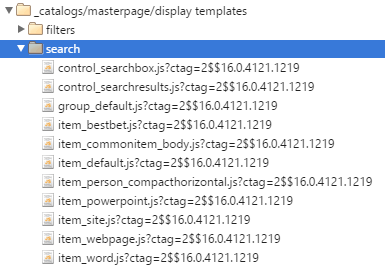Optimizing the number of display templates that get loaded for the search result web part
This post is over a year old, some of this information may be out of date.
This week I saw a question on StackExchange about optimizing a search page and how to get rid of the pre-loaded display templates. You can quickly check the templates that get pre-loaded by opening an OOTB SharePoint search center results page, and checking the loaded scripts via Fiddler or your browser developer tools. For a default search results page, you will see that the following display templates get loaded (even when no results are returned):

The number of templates that get loaded by default could have some impact when loading your page. But also if you developed your own display templates for your search center. You do not want to overload the default templates which will stay unused probably.
To fix this, the search results web part has a property called PreloadedItemTemplateIdsJson With this property you can define the templates that need to be pre-loaded on your page. This property can be checked by exporting the search results web part. Once you exported the web part and open the file, you can find the following line:

You can just remove the unnecessary templates from the property.
Important: If you want that the web part does not pre-load these templates, you have to leave only the brackets in place. Do not remove these brackets, otherwise the web part will use a hard-coded fallback list (which is the same as the picture above) and pre-loads these templates.

Once you did your updates to the web part file, and uploaded it back to the site, you can see that the templates aren’t loaded anymore.

Note: you can also make these property updates to the web part property via PowerShell.
Related articles
Creating Custom Refiner Control Display Templates for SharePoint 2013
Part 1: Create Your First Search Refiner Control Template
Part 2: Adding Refinement Actions to the Custom Search Refiner Control
Report issues or make changes on GitHub
Found a typo or issue in this article? Visit the GitHub repository to make changes or submit a bug report.
Comments
Let's build together
Manage content in VS Code
Present from VS Code
Engage with your audience throughout the event lifecycle
